The James Webb Space Telescope (JWST) is a powerful new telescope that is set to revolutionize our understanding of the universe. One of its most exciting targets is exoplanet WASP-39b, a gas giant located about 700 light-years away from Earth. In this article, we will explore what WASP-39b is, why it is important, and what the JWST’s findings may reveal about this distant world.
What is WASP-39b?
WASP-39b is an exoplanet, which means it is a planet that orbits a star outside of our solar system. It was first discovered in 2011 by the Wide Angle Search for Planets (WASP) project, which uses ground-based telescopes to search for exoplanets. WASP-39b is a gas giant, similar in size and composition to Jupiter, but it orbits its star much more closely, completing one orbit in just four days.
WASP-39b is located in the constellation Virgo, about 700 light-years away from Earth. Its parent star, WASP-39, is a yellow dwarf star that is slightly smaller and cooler than the Sun.
Why is WASP-39b important?
WASP-39b is important for several reasons. First, it is a prime target for studying the processes of planet formation and evolution. Gas giants like WASP-39b are thought to form in the outer regions of their solar systems and migrate inward over time. Studying the properties of these planets can help astronomers to better understand the mechanisms of planet formation and migration.
Second, WASP-39b is a good target for studying the atmospheres of exoplanets. Gas giants like WASP-39b have thick atmospheres that are rich in hydrogen and helium, which make them difficult to study with ground-based telescopes. However, the JWST’s advanced instruments will be able to detect the chemical composition of WASP-39b’s atmosphere with unprecedented precision, providing valuable insights into the planet’s composition, temperature, and weather patterns.
Finally, WASP-39b is a good candidate for studying the effects of star-planet interactions. The planet’s close proximity to its parent star means that it is subjected to intense radiation and gravitational forces. Studying how these forces affect the planet’s atmosphere and structure can provide important clues about the evolution of planetary systems.
What did the JWST find?
The JWST’s observations of WASP-39b revealed a number of interesting features. First, the telescope detected the presence of water vapor in the planet’s atmosphere. This is significant because water vapor is a key indicator of a planet’s habitability. While WASP-39b is too hot and too close to its parent star to support life as we know it, the detection of water vapor suggests that other, potentially habitable planets may also have water in their atmospheres.
In addition to water vapor, the JWST also detected the presence of sodium and potassium in WASP-39b’s atmosphere. These elements are important because they can provide clues about the planet’s formation and evolution. For example, the ratio of sodium to potassium can reveal whether the planet formed through core accretion or gravitational instability.
The JWST also detected a temperature inversion in WASP-39b’s atmosphere. This means that the upper layers of the planet’s atmosphere are hotter than the lower layers, which is the opposite of what is typically seen in gas giants. The cause of this temperature inversion is not yet clear, but it could be due to the planet’s proximity to its parent star or to the presence of high-altitude clouds in the atmosphere.
Finally, the JWST’s observations of WASP-39b revealed a complex weather system in the planet’s atmosphere.

